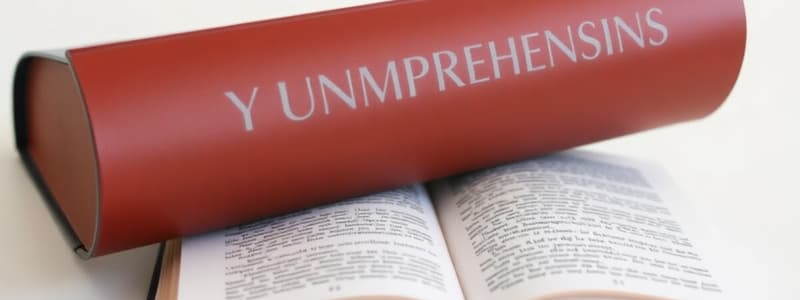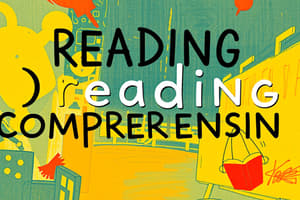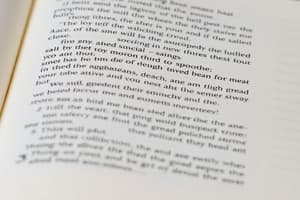Podcast
Questions and Answers
A third-grade student is reading a passage about the solar system. They encounter the word ' ' (grahanu), which is unfamiliar. Which strategy would be most effective for them to determine the meaning of this word?
A third-grade student is reading a passage about the solar system. They encounter the word ' ' (grahanu), which is unfamiliar. Which strategy would be most effective for them to determine the meaning of this word?
- Reread the sentence and surrounding sentences to look for context clues about ' '. (correct)
- Ask a friend or teacher for the definition of ' '.
- Use a dictionary to look up the definition of ' '.
- Skip the word and continue reading to understand the general context.
To quickly find information about the lifecycle of a butterfly in an online article, what is the most efficient text feature to use?
To quickly find information about the lifecycle of a butterfly in an online article, what is the most efficient text feature to use?
- Scanning headings and subheadings for keywords like 'lifecycle' or 'stages'. (correct)
- Looking at image captions for keywords.
- Reading every paragraph carefully.
- Using the table of contents to navigate to relevant sections.
A text describes how volcanoes erupt. What is most likely the author's main purpose in writing this text?
A text describes how volcanoes erupt. What is most likely the author's main purpose in writing this text?
- To entertain readers with exciting stories about volcanoes.
- To explain the process of volcanic eruptions. (correct)
- To persuade readers to visit volcanic areas.
- To describe the different types of rocks found near volcanoes.
Which sentence demonstrates an understanding of antonyms?
Which sentence demonstrates an understanding of antonyms?
A student is writing a report on dogs. They find a picture of a Golden Retriever in a book. How can this illustration best help them understand the text?
A student is writing a report on dogs. They find a picture of a Golden Retriever in a book. How can this illustration best help them understand the text?
In a paragraph describing the causes of the American Revolution, which sentence would most likely introduce a reason supporting the main point?
In a paragraph describing the causes of the American Revolution, which sentence would most likely introduce a reason supporting the main point?
You are reading two different articles about pandas. One article focuses on panda habitats, and the other describes panda diets. What would be the best way to understand the main points of both texts?
You are reading two different articles about pandas. One article focuses on panda habitats, and the other describes panda diets. What would be the best way to understand the main points of both texts?
Which of the following words is NOT an example of a compound word?
Which of the following words is NOT an example of a compound word?
A child reads the sentence: 'The dog barked loudly.' If the child struggles to read 'barked,' which word analysis skill would be most helpful to decode it?
A child reads the sentence: 'The dog barked loudly.' If the child struggles to read 'barked,' which word analysis skill would be most helpful to decode it?
What does it mean to read with fluency?
What does it mean to read with fluency?
After reading a story, a teacher asks, 'Who was the main character and what problem did they face?' What reading comprehension skill is the teacher assessing?
After reading a story, a teacher asks, 'Who was the main character and what problem did they face?' What reading comprehension skill is the teacher assessing?
Which question best helps determine the main idea of a story?
Which question best helps determine the main idea of a story?
A text describes the events leading up to the Civil War. Which phrase would signal a cause-and-effect relationship in the text?
A text describes the events leading up to the Civil War. Which phrase would signal a cause-and-effect relationship in the text?
Identify the quadrilateral from the following options.
Identify the quadrilateral from the following options.
A square is divided into four equal parts. What fraction represents one of these parts?
A square is divided into four equal parts. What fraction represents one of these parts?
Which of these shapes is NOT always a rhombus?
Which of these shapes is NOT always a rhombus?
If you measure a table's length first in feet and then in inches, which measurement will have a larger numerical value?
If you measure a table's length first in feet and then in inches, which measurement will have a larger numerical value?
Estimate the length of a standard school bus. Which is the most reasonable estimate?
Estimate the length of a standard school bus. Which is the most reasonable estimate?
Object A is 15 cm long. Object B is 8 cm long. How much longer is Object A than Object B?
Object A is 15 cm long. Object B is 8 cm long. How much longer is Object A than Object B?
A number line diagram starts at 0 and goes to 10, with equal spaces marked for each whole number. Where would you represent the number 7?
A number line diagram starts at 0 and goes to 10, with equal spaces marked for each whole number. Where would you represent the number 7?
A movie starts at 7:15 PM and ends at 9:00 PM. How long is the movie?
A movie starts at 7:15 PM and ends at 9:00 PM. How long is the movie?
Which unit is most appropriate for measuring the volume of water in a bathtub?
Which unit is most appropriate for measuring the volume of water in a bathtub?
A recipe requires 2 liters of water. If you only have a measuring cup marked in milliliters, how many milliliters do you need?
A recipe requires 2 liters of water. If you only have a measuring cup marked in milliliters, how many milliliters do you need?
A bar graph shows the number of students who like different fruits. The bar for 'Apples' reaches 8, and for 'Bananas' it reaches 12. How many more students like bananas than apples?
A bar graph shows the number of students who like different fruits. The bar for 'Apples' reaches 8, and for 'Bananas' it reaches 12. How many more students like bananas than apples?
What type of graph is best for showing parts of a whole, like percentages of favorite colors in a class?
What type of graph is best for showing parts of a whole, like percentages of favorite colors in a class?
A line plot shows the lengths of leaves collected by students. Most of the 'X' marks are above the 5-inch and 6-inch marks. What does this tell you about the leaves?
A line plot shows the lengths of leaves collected by students. Most of the 'X' marks are above the 5-inch and 6-inch marks. What does this tell you about the leaves?
What is the area of a square with sides that are each 4 cm long?
What is the area of a square with sides that are each 4 cm long?
The perimeter of a rectangle is 20 cm. If the length is 6 cm, what is the width?
The perimeter of a rectangle is 20 cm. If the length is 6 cm, what is the width?
Solve: 8 + ? = 15
Solve: 8 + ? = 15
What is 7 x 6?
What is 7 x 6?
Interpret $24 \div 4$. Which statement is correct?
Interpret $24 \div 4$. Which statement is correct?
Which number sentence shows the commutative property of multiplication?
Which number sentence shows the commutative property of multiplication?
What is another way to think of $30 \div 5 = ?$?
What is another way to think of $30 \div 5 = ?$?
A baker makes 5 trays of cookies with 9 cookies on each tray. How many cookies did they make in total?
A baker makes 5 trays of cookies with 9 cookies on each tray. How many cookies did they make in total?
What is the value of the unknown in the equation $12 + ? = 25$?
What is the value of the unknown in the equation $12 + ? = 25$?
Identify the pattern in the sequence: 2, 4, 6, 8, __
Identify the pattern in the sequence: 2, 4, 6, 8, __
What does the digit '7' represent in the number 732?
What does the digit '7' represent in the number 732?
Which of these numbers is closest to 1000?
Which of these numbers is closest to 1000?
Write the number 528 in word form.
Write the number 528 in word form.
Compare 678 and 687. Which symbol correctly compares these numbers?
Compare 678 and 687. Which symbol correctly compares these numbers?
Calculate 456 + 321.
Calculate 456 + 321.
What is 100 more than 585?
What is 100 more than 585?
Round 67 to the nearest ten.
Round 67 to the nearest ten.
Calculate 789 - 234.
Calculate 789 - 234.
What is $8 imes 60$?
What is $8 imes 60$?
What fraction represents one part of a whole divided into 3 equal parts?
What fraction represents one part of a whole divided into 3 equal parts?
Which point on a number line represents 1/2?
Which point on a number line represents 1/2?
Are 2/4 and 1/2 equivalent fractions?
Are 2/4 and 1/2 equivalent fractions?
What is the purpose of an opinion piece?
What is the purpose of an opinion piece?
What is the main goal of informative writing?
What is the main goal of informative writing?
In a narrative, what is the purpose of temporal words like 'first,' 'then,' and 'finally'?
In a narrative, what is the purpose of temporal words like 'first,' 'then,' and 'finally'?
Flashcards
Determine word meaning
Determine word meaning
Determine the meaning of general academic and domain-specific words and phrases in a text relevant to a grade 3 topic or subject area.
Use text features
Use text features
Use text features and search tools (e.g., key words, sidebars, hyperlinks) to locate information relevant to a given topic efficiently.
Identify text's purpose
Identify text's purpose
Identify the main purpose of a text, including what the author wants to answer, explain, or describe.
Clarify word meanings
Clarify word meanings
Signup and view all the flashcards
Understand word relationships
Understand word relationships
Signup and view all the flashcards
Describe reasons
Describe reasons
Signup and view all the flashcards
Integrate illustrations
Integrate illustrations
Signup and view all the flashcards
Compare and contrast texts
Compare and contrast texts
Signup and view all the flashcards
Read fluently
Read fluently
Signup and view all the flashcards
Ask and answer questions
Ask and answer questions
Signup and view all the flashcards
Determine main idea
Determine main idea
Signup and view all the flashcards
Describe relationships in texts
Describe relationships in texts
Signup and view all the flashcards
Recognize shapes
Recognize shapes
Signup and view all the flashcards
Partition shapes
Partition shapes
Signup and view all the flashcards
Interpret quotients
Interpret quotients
Signup and view all the flashcards
Solve equal group problems
Solve equal group problems
Signup and view all the flashcards
Multiply and divide fluently
Multiply and divide fluently
Signup and view all the flashcards
Add/subtract within 1000
Add/subtract within 1000
Signup and view all the flashcards
Round numbers
Round numbers
Signup and view all the flashcards
Write opinion pieces
Write opinion pieces
Signup and view all the flashcards
Study Notes
- Determine the meaning of academic and subject-specific words/phrases in a grade 3 text.
- Use text features and search tools to efficiently find topic-relevant information.
- Identify the author's purpose: to answer, explain, or describe.
- Determine/clarify the meaning of unknown and multiple-meaning words/phrases using grade 2 reading and content strategies.
- Demonstrate understanding of word relationships and meaning nuances.
- Explain how reasons support specific points.
- Use information from illustrations and text to understand where, when, why, and how key events occur.
- Compare/contrast the most important points and details in two texts on the same topic.
- Apply grade-level phonics and word analysis skills in decoding.
- Read with accuracy and fluency to support comprehension.
- Answer questions (who, what, where, when, why, how) to show understanding of key text details.
Key Ideas and Details
- Answer questions (who, what, where, when, why, how) to show understanding of key text details.
- Determine the main idea and supporting details.
- Describe relationships between historical events, scientific ideas, concepts, or steps in technical procedures, using time, sequence, and cause/effect language.
Geometry
- Recognize and draw shapes with specific attributes (e.g., angles, faces).
- Identify triangles, quadrilaterals, pentagons, hexagons, and cubes.
- Divide circles and rectangles into two, three, or four equal shares and describe them using terms like halves, thirds, and fourths.
- Recognize equal shares don't need to have the same shape.
- Shapes in different categories (rhombuses, rectangles, etc.) share attributes, defining larger categories (quadrilaterals).
- Recognize/draw rhombuses, rectangles, squares as quadrilaterals.
- Partition shapes into equal areas, expressing each part's area as a unit fraction.
- Measure an object's length twice using different length units and describe the relationship between measurements and the unit's size.
- Estimate lengths using inches and feet.
- Measure how much longer one object is than another, expressing the length difference in standard units.
- Represent whole number lengths on a number line diagram and represent whole-number sums and differences within 100.
- Tell and write time to the nearest minute; measure time intervals in minutes, solve word problems involving addition and subtraction of time intervals using number line diagrams.
Measurement, Data, and Probability
- Measure/estimate liquid volumes and masses using grams, kilograms, and liters.
- Solve one-step word problems involving masses or volumes in the same units.
- Draw picture and bar graphs (single-unit scale) to represent data sets (up to four categories).
- Solve put-together, take-apart, and comparison problems using graph data.
- Draw scaled picture and bar graphs with several categories.
- Solve one- and two-step "how many more" and "how many less" problems from scaled bar graphs.
- Generate measurement data by measuring lengths with rulers marked in halves and fourths of an inch, presenting data as a line plot.
- Measure areas by counting unit squares (cm², m², in², ft², improvised units).
- Solve real-world perimeter problems, including finding perimeter given side lengths or an unknown side length.
- Exhibit rectangles with the same perimeter and different areas or the same area and different perimeters.
- Use addition and subtraction within 100 to solve one- and two-step word problems with unknowns in all positions, using drawings and equations.
- Fluently add and subtract within 20 using mental strategies.
- Interpret products of whole numbers, e.g., 5 x 7 as the total number of objects in 5 groups of 7.
Algebraic Concepts
- Interpret whole-number quotients, e.g., 56 ÷ 8 as the number of objects in each share when 56 objects are split equally into 8 shares.
- Use multiplication/division within 100 to solve word problems involving equal groups, arrays, and measurement quantities.
- Use drawings/equations with a symbol to represent the unknown number.
- Determine the unknown whole number in a multiplication or division relating three whole numbers.
- Apply properties of operations as strategies.
- Division as an unknown-factor problem.
- Fluently multiply/divide within 100 using strategies like the relationship between multiplication/division or properties of operations.
- Solve two-step word problems with four operations; represent problems using equations with a letter for the unknown quantity and assess reasonableness.
- Identify arithmetic patterns (addition/multiplication tables) and strategies.
- Understand three-digit numbers represent amounts of hundreds, tens, and ones.
- Count within 1000; skip-count by 5s, 10s, and 100s.
- Read/write numbers to 1000 using base-ten numerals, number names, and expanded form.
- Compare three-digit numbers based on hundreds, tens, and ones digits, using >, =, < to record comparisons.
Numbers and Operations
- Add/subtract within 1000 using concrete models, drawings, place value strategies, properties of operations, and/or the relationship between addition and subtraction; relate to a written method.
- Add/subtract hundreds, tens, and ones (sometimes it is necessary to compose or decompose tens or hundreds).
- Mentally add/subtract 10 or 100 to/from numbers between 100–900.
- Use place value understanding to round whole numbers to the nearest 10 or 100.
- Fluently add/subtract within 1000 using strategies/algorithms based on place value, properties of operations, and/or the addition/subtraction relationship.
- Multiply one-digit numbers by multiples of 10 in the range 10–90, using place value/properties.
- Understand a fraction 1/b as one part of a whole divided into b equal parts: understand a fraction a/b as the quantity formed by a parts of size 1/b.
- Understand a fraction as a number on the number line: represent fractions on a number line diagram.
- Explain fraction equivalence in special cases and compare fractions by reasoning about their size.
Standard English and Purposes
- Write opinion pieces on topics/texts, supporting a point of view with reasons.
- Write informative/explanatory texts, examining a topic and conveying information.
- Write narratives recounting an event or short sequence of events with details, actions, thoughts, feelings, temporal words, and closure.
- Demonstrate command of standard English grammar/usage when writing/speaking.
- Demonstrate command of standard English capitalization, punctuation, and spelling when writing.
- Use knowledge of language and its conventions when writing, speaking, reading, or listening.
- Determine/clarify meanings of unknown/multiple-meaning words/phrases based on grade 2 reading/content, choosing flexibly from strategies.
- Demonstrate understanding of word relationships and nuances in meanings.
- Use words and phrases acquired through conversations, reading, and responding to texts, including adjectives and adverbs to describe.
Knowledge of Language and Vocabulary
- Acquire/use grade-appropriate conversational, general academic, and domain-specific words/phrases, including those signaling spatial/temporal relationships.
Studying That Suits You
Use AI to generate personalized quizzes and flashcards to suit your learning preferences.




